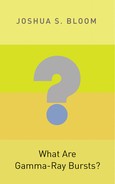SUGGESTIONS FOR FURTHER READING
Many of the primary works where ideas or discoveries were first presented are referenced in the Notes. The easiest path to getting those works in a readable form is through the SAO/NASA Astrophysics Data System (ADS; http://adsabs.harvard.edu), a digital portal for physics and astronomy publications. Access to the published versions of some newer works will require that your home institution (e.g., a university) has an account with that specific publisher. Older publications should be retrievable by everyone. In most cases, even if access is restricted to the published version, you should be able to retrieve a preprint draft of the paper through the arXiv e-print link at the ADS site.
What follows is a listing of some overview works, either review articles or related books. Limited previews of most books can be found at Google Books (http://books.google.com).
Historical Perspectives
- Flash! The Hunt for the Biggest Explosions in the Universe, Govert Schilling (2002; Cambridge University Press): a wonderful popular-level account of the GRB story, focused on the beginning of the afterglow era. Biggest Bangs, Jonathan Katz (2002; Oxford University Press) is also a popular-level book written by a practicing theorist in the field. These books focus on the history of GRBs and the early days of the afterglow era, but many of the most transformative discoveries and insights you read here occurred after these books were published.
- Articles from the Great Debate summarizing the case for the Galactic and extragalactic distance scales: “The Distance Scale to Gamma-Ray Bursts,” D. Q. Lamb (1995; Publications of the Astronomical Society of the Pacific, Vol. 107, p. 1152) and “How Far Away Are Gamma-Ray Bursters?,” Bohdan Paczy
 ski (1995; Publications of the Astronomical Society of the Pacific, Vol. 107, p. 1167).
ski (1995; Publications of the Astronomical Society of the Pacific, Vol. 107, p. 1167).
High-Energy Emission and Afterglows
- Gamma-Ray Bursts: The Brightest Explosions in the Universe, Gilbert Vedrenne and Jean-Luc Atteia (2009; Springer Praxis Books). An in-depth look at the theory and observations of GRBs and afterglows. This book covers a similar array of topics as do I but is geared more for the practitioner in the GRB field or graduate students.
- Gamma-ray Bursts in the Afterglow Era: Proceedings of the International Workshop, Held in Rome, Italy, 17–20 October 2000, edited by Enrico Costa, Filippo Frontera, and Jens Hjorth (2001; Springer). Not particularly current but a good technical snapshot of our understanding of the GRB phenomenon well into the afterglow era.
- Gamma-Ray Bursts in the Swift Era, Neil Gehrels, Enrico Ramirez-Ruiz, Derek B. Fox (2009; Annual Review of Astronomy and Astrophysics, vol. 47, pp. 567–617). A very good technical review of the current state of GRB research in 2009.
- The Physics of Gamma-ray Bursts, Tsvi Piran (2004; Reviews of Modern Physics, vol. 76, No. 4, pp. 1143–1210) and Gamma-ray bursts, Peter Mészáros (2006; Reports on Progress in Physics, vol. 69, No. 8, pp. 2259–2321). Two technical reviews, focused on the theory of GRBs and afterglows.
The Supernova Connection
- Cosmic Catastrophes: Exploding Stars, Black Holes, and Mapping the Universe, J. Craig Wheeler (2008; Cambridge University Press). A popular account of the life cycles of stars that go bang, with a focus on the origins of supernovae.
- Supernovae and Gamma-ray Bursters: Volume 598 of Lecture Notes in Physics, edited by Kurt Walter Weiler (2003; Springer). A collection of short technical articles by prominent astronomers covering supernovae and GRBs.
- The Supernova Gamma-ray Burst Connection, Stan Woosley and Joshua Bloom (2006;Annual Review of Astronomy and Astrophysics, vol. 44, No. 1, pp. 507–556). A technical overview of the observational and theoretical connection of GRBs, massive stars, and supernovae.
Universal Context
- Cosmology, Steven Weinberg (2008; Oxford University Press). A comprehensive, graduate-student-level overview of model cosmology from the Nobel Prize-winning author of the immensely popular The First Three Minutes.
- The Extravagant Universe: Exploding Stars, Dark Energy, and the Accelerating Cosmos, Robert P. Kirshner (2004; Princeton University Press). A humorous, popular-level account of modern cosmology and the discovery of an accelerating universe.
